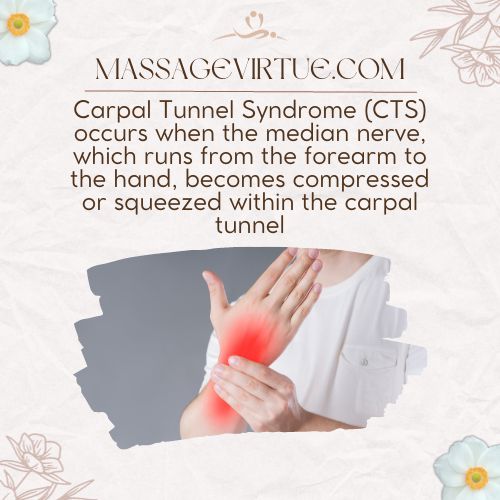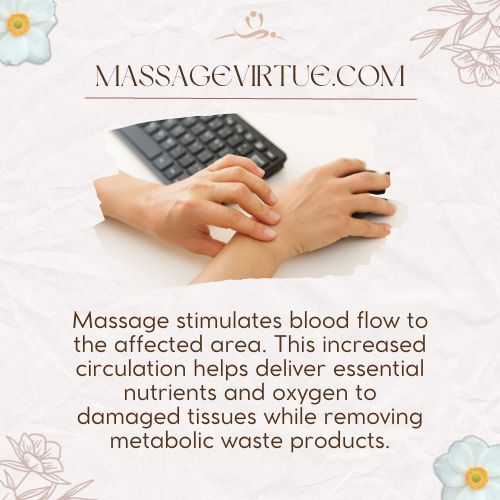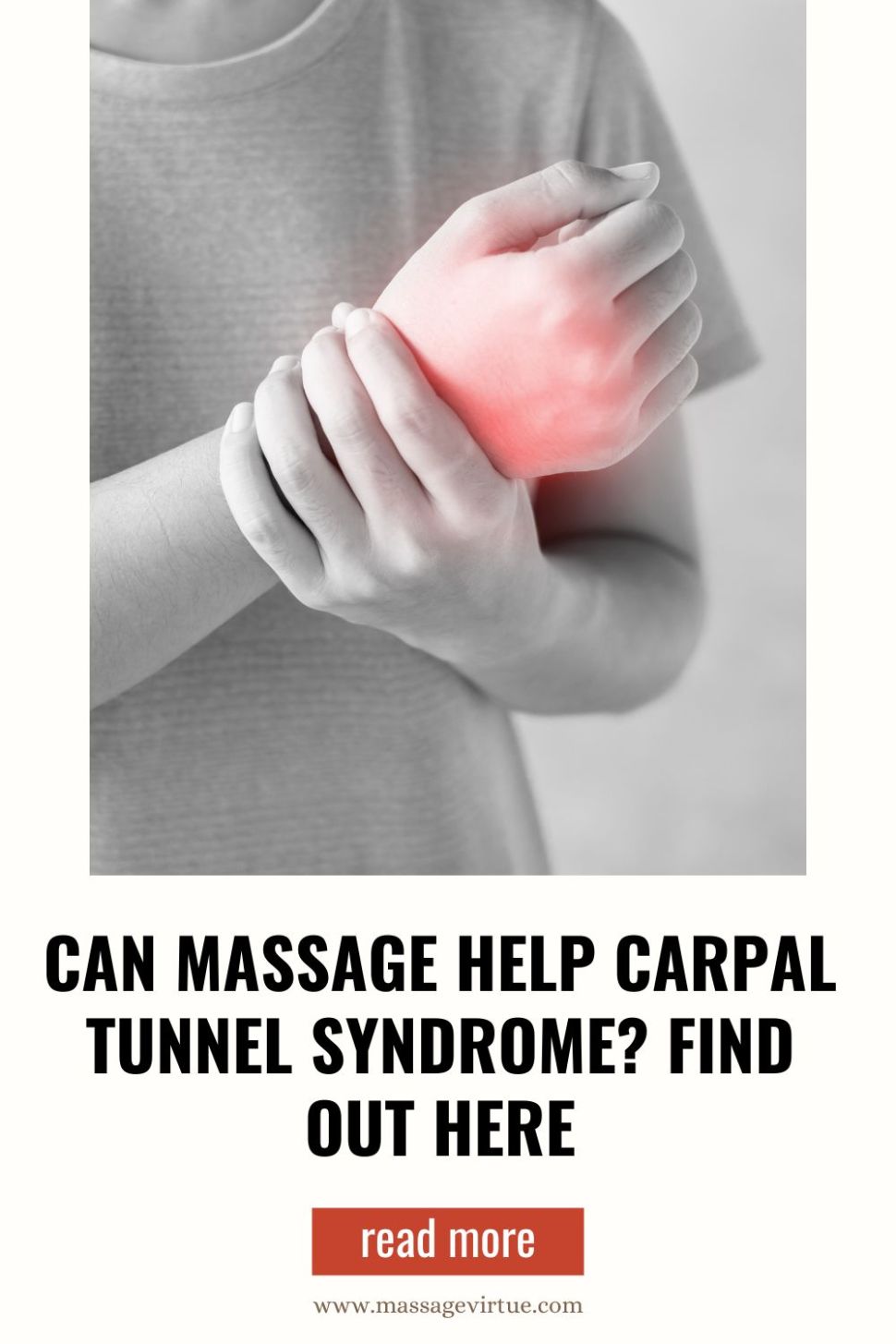Carpal Tunnel Syndrome (CTS) is a common condition that affects many individuals, causing pain, numbness, and discomfort in the wrist and hand.
If you’re dealing with the daily struggles of CTS, you’ve probably explored various treatment options.
While surgical interventions and medications are often considered, have you ever thought about the potential benefits of massage therapy for carpal tunnel syndrome?
In this comprehensive guide, we will explore how massage can offer relief, reduce symptoms, and improve your overall well-being.
What is Carpal Tunnel Syndrome?
Before delving into the potential benefits of massage therapy, it’s crucial to have a basic understanding of Carpal Tunnel Syndrome.

Carpal Tunnel Syndrome (CTS) occurs when the median nerve, which runs from the forearm to the hand, becomes compressed or squeezed within the carpal tunnel—a narrow passageway in the wrist.
This compression can result in various symptoms, including pain, numbness, tingling, and weakness in the affected hand.
Can Massage Help Carpal Tunnel Syndrome?
Yes, massage can help carpal tunnel syndrome by reducing inflammation and pain, improving circulation, and releasing muscle tension.
Massage can also help to improve nerve function and range of motion in the wrist and hand.
The best type of massage for carpal tunnel syndrome is a combination of deep tissue massage and myofascial release.
Deep tissue massage helps to loosen tight muscles and fascia (the connective tissue that surrounds muscles), while myofascial release helps to release trigger points, which are areas of muscle tension that can cause pain and referred pain.
Massage is a safe and effective treatment for carpal tunnel syndrome, but it is important to find a qualified massage therapist who specializes in treating this condition.
Benefits of Massage Therapy for Carpal Tunnel Syndrome
Now, let’s focus on the potential benefits of massage therapy for Carpal Tunnel Syndrome. Massage is a non-invasive treatment option that aims to alleviate CTS symptoms. Here’s how it can help:
1. Muscle Relaxation
Massage therapy involves the manipulation of soft tissues, which can effectively relax tight muscles around the wrist and forearm.
By reducing muscle tension, the pressure on the median nerve within the carpal tunnel can be alleviated, leading to pain relief and improved mobility.
2. Increased Blood Circulation
Massage stimulates blood flow to the affected area.
This increased circulation helps deliver essential nutrients and oxygen to damaged tissues while removing metabolic waste products.

Improved blood flow can aid in the healing process and reduce swelling.
3. Reduction in Inflammation
Inflammation is a key contributor to CTS symptoms.
Massage can help reduce inflammation by promoting lymphatic drainage and encouraging the body’s natural healing processes.
This, in turn, can lead to a reduction in pain and discomfort.
4. Enhanced Range of Motion
As the muscles and soft tissues around the wrist and hand become more relaxed and flexible through massage, individuals with CTS often experience an improvement in their range of motion.
This can result in less stiffness and greater ease of movement.
What Is the Pressure Point Massage for Carpal Tunnel?
| Pressure Point | Location | Benefits |
| Neiguan (Pericardium 6) | Inner forearm, about 2 inches up from the wrist crease | Reduces wrist pain and numbness |
| Hegu (Large Intestine 4) | Webbing between the thumb and index finger | Alleviates wrist discomfort |
| Jianshi (Gallbladder 21) | Top of the shoulder | Relieves tension contributing to CTS symptoms |
Incorporating Massage into Your CTS Treatment Plan
If you’re considering massage therapy as part of your CTS treatment plan, here are some essential steps to take:
1. Consult with a Healthcare Professional: Before starting any new treatment, consult with your healthcare provider or a certified massage therapist. They can assess your specific condition and recommend an appropriate course of action.
2. Choose a Qualified Massage Therapist: Look for a licensed and experienced massage therapist who has expertise in treating individuals with CTS. They should understand the condition and tailor their approach accordingly.
3. Communicate Your Needs: During your massage session, communicate your symptoms, pain levels, and any concerns to the therapist. This helps them provide personalized and effective treatment.
4. Consistency is Key: Massage therapy may require multiple sessions to achieve the desired results. Be prepared to commit to a series of treatments as part of your overall CTS management plan.
Conclusion
In summary, massage therapy can be a valuable addition to your treatment plan for Carpal Tunnel Syndrome.
Its ability to relax muscles, increase blood circulation, reduce inflammation, and enhance range of motion makes it a promising non-invasive option for managing CTS symptoms.
Remember that while massage can provide relief, it may not be a standalone solution for severe cases of CTS.
FAQs
What Type of Massage Is Good for Carpal Tunnel?
Massage for Carpal Tunnel Syndrome (CTS) can encompass various techniques such as Swedish Massage, Deep Tissue Massage, Myofascial Release, Trigger Point Therapy, and Neuromuscular Therapy.
These methods can help relax muscles, improve circulation, reduce inflammation, and alleviate CTS symptoms.
How Do You Release the Nerve from Carpal Tunnel?
Relieving the compressed median nerve in CTS can involve wrist splints, physical therapy, massage therapy, or carpal tunnel release surgery.
These methods aim to reduce nerve pressure, improve circulation, and alleviate symptoms.
What Should You Not Do with Carpal Tunnel?
To manage CTS, avoid activities involving repetitive hand movements without breaks, ensure ergonomic workspace setups, minimize wrist flexion or extension, and promptly address symptoms.
Seek professional medical advice rather than self-diagnosing or self-treating the condition.


